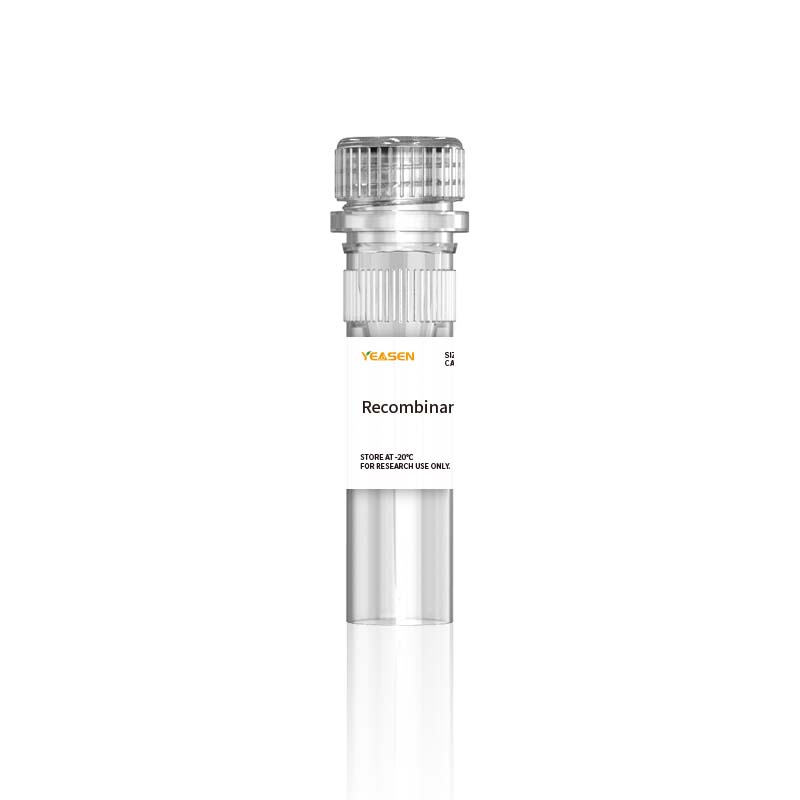Description
ErbB3, also called Her3 (human epidermal growth factor receptor 3), is a type I membrane glycoprotein that is a member of the ErbB family of tyrosine kinase receptors. ErbB family members serve as receptors for the epidermal growth factor (EGF) family of growth factors. Among ErbB family members, ErbB3 is unique in that it contains a defective kinase domain. ErbB3 is expressed in keratinocytes, melanocytes, skeletal muscle cells, embryonic myoblasts and Schwann cells. Monomeric ErbB3 serves as a low affinity receptor for the heregulins (HRG). ErbB3 heterodimerizes with ErbB2 to form a high affinity receptor complex. In contrast, ErbB3 homodimerization or heterodimerization with ErbB4 forms a low affinity heregulin-binding complex. Because ErbB3 contains a defective kinase domain, the kinase domain of ErbB2 is responsible for initiating the tyrosine phosphorylation signal through the heterodimeric receptor. It has been found that a discrete three amino acid signal in the ErbB3 cytoplasmic domain is critical for transactivation of ErbB2. The cytoplasmic domain of ErbB3 also contains six consensus binding motifs for the SH2 domain of the regulatory p85 subunit of phosphoinositide 3-kinase (PI 3-kinase, PI3K) as well as one proline-rich consensus binding motif for the SH3 domain of p85. Human ErbB3 consists of 1342 amino acids (aa) with a 19 aa signal sequence, a 624 aa extracellular domain, a 21 aa transmembrane region, and a 678 aa cytoplasmic domain. ErbB3 appears to play roles in development, cancer, communication at the neuromuscular junction and regulation of cell growth and differentiation.
Specifications
|
Synonyms |
ErbB3; ErbB-3; HER3; HER3c-erbB-3; LCCS2; MDA-BF-1; MGC88033; p180-ErbB3; p45-sErbB3; p85-sErbB3; ERBB3 |
|
Uniprot No. |
|
|
Source |
Recombinant Human Her3/ErbB3 Protein is expressed from HEK293 Cells with hFc tag at the C-terminal. It contains Ser20-Thr643. |
|
Molecular Weight |
The protein has a predicted MW of 95.4 kDa. Due to glycosylation, the protein migrates to 110-120 kDa based on Tris-Bis PAGE result. |
|
Physical Appearance |
Sterile Filtered White lyophilized (freeze-dried) powder. |
|
Purity |
> 95% as determined by SDS-PAGE and HPLC |
|
Activity |
ELISA Data:Immobilized Human Her3, hFc Tag at 0.5μg/ml (100μl/well) on the plate. Dose response curve for Biotinylated Anti-Her3 Antibody, hFc Tag with the EC50 of 13.5ng/ml determined by ELISA. |
|
Endotoxin |
< 1.0 EU per 1μg of the protein by the LAL method. |
|
Formulation |
Lyophilized from 0.22 μm filtered solution in PBS (pH 7.4). Normally 5% trehalose is added as protectant before lyophilization. |
|
Reconstitution |
Centrifuge tubes before opening. Reconstituting to a concentration more than 100 μg/mL is recommended (usually we use 1 mg/mL solution for lyophilization). Dissolve the lyophilized protein in distilled water. |
Storage
The product should be stored at -20~-80℃ for 1 year from date of receipt.
2-7 days, 2 ~8 °C under sterile conditions after reconstitution.
3-6 months, -20~-80℃ under sterile conditions after reconstitution.
Recommend to aliquot the protein into smaller quantities when first used and avoid repeated freeze-thaw cycles.
Note
1. Avoid repeated freezing and thawing.
2. Please operate with lab coats and disposable gloves, for your safety.
3. This product is for research use only.
Product Data
Tris-Bis PAGE

Payment & Security
Your payment information is processed securely. We do not store credit card details nor have access to your credit card information.
Inquiry
You may also like
FAQ
The product is for research purposes only and is not intended for therapeutic or diagnostic use in humans or animals. Products and content are protected by patents, trademarks, and copyrights owned by Yeasen Biotechnology. Trademark symbols indicate the country of origin, not necessarily registration in all regions.
Certain applications may require additional third-party intellectual property rights.
Yeasen is dedicated to ethical science, believing our research should address critical questions while ensuring safety and ethical standards.

